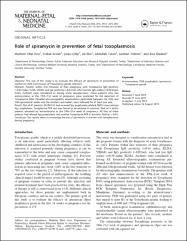| dc.contributor.author | Avcı, Muhittin Eftal | |
| dc.contributor.author | Arslan, Ferhat | |
| dc.contributor.author | Çiftci, Şinasi | |
| dc.contributor.author | Ekiz, Ali | |
| dc.contributor.author | Tüten, Abdullah | |
| dc.contributor.author | Yıldırım, Gökhan | |
| dc.contributor.author | Madazlı, Rıza | |
| dc.date.accessioned | 10.07.201910:49:13 | |
| dc.date.accessioned | 2019-07-10T19:58:32Z | |
| dc.date.available | 10.07.201910:49:13 | |
| dc.date.available | 2019-07-10T19:58:32Z | |
| dc.date.issued | 2016 | en_US |
| dc.identifier.citation | Avcı, M. E., Arslan, F., Çiftci, Ş., Ekiz, A., Tüten, A., Yıldırım, G. ... Madazlı, R. (2016). Role of spiramycin in prevention of fetal toxoplasmosis. Journal Of Maternal-Fetal & Neonatal Medicine, 29(13), 2073-2076. https://dx.doi.org/10.3109/14767058.2015.1074998 | en_US |
| dc.identifier.issn | 1476-7058 | |
| dc.identifier.issn | 1476-4954 | |
| dc.identifier.uri | https://dx.doi.org/10.3109/14767058.2015.1074998 | |
| dc.identifier.uri | https://hdl.handle.net/20.500.12511/3188 | |
| dc.description | WOS: 000374773800006 | en_US |
| dc.description | PubMed ID: 26365472 | en_US |
| dc.description.abstract | Objective: The aim of this study is to evaluate the efficacy of spiramycin in prevention of mother-to-child transmission of Toxoplasma gondii infection. Methods: Patients within first trimester of their pregnancy with Toxoplasma IgM positivity (>0.65 index, ELISA, VIDAS) and IgG positivity (>8 IU/ml), who had low IgG avidity (<0.50 index, ELISA, Architet) were considered as having acute toxoplasmosis. These patients who had amniocentesis at the 19th-21st week of pregnancy were examined for the detection of Toxoplasma DNA. Detailed ultrasonographic examinations performed between the 20th and 24th gestational weeks and the mothers and babies were followed for at least one year. Results: Out of 61 patients, 55 (90.2%) had received Spy prophylaxis while 6 (9.8%) cases refused Spy prophylaxis. Toxoplasma PCR test was found to be positive in amniotic fluid of 4 (6.6%) patients obtained by amniocentesis at the 19th-21st week of pregnancy. All four of these patients had refused Spy prophylaxis had positive Toxoplasma PCR in amniotic fluid (p<0.01). Conclusion: Our results seem to encourage the use of spiramycin in women with toxoplasmosis during pregnancy. | en_US |
| dc.language.iso | eng | en_US |
| dc.publisher | Taylor & Francis Ltd | en_US |
| dc.rights | info:eu-repo/semantics/openAccess | en_US |
| dc.subject | Amniocentesis | en_US |
| dc.subject | PCR | en_US |
| dc.subject | Prophylaxis | en_US |
| dc.subject | Spiramycin | en_US |
| dc.subject | Toxoplasma Gondii | en_US |
| dc.title | Role of spiramycin in prevention of fetal toxoplasmosis | en_US |
| dc.type | article | en_US |
| dc.relation.ispartof | Journal Of Maternal-Fetal & Neonatal Medicine | en_US |
| dc.department | İstanbul Medipol Üniversitesi, Tıp Fakültesi, Dahili Tıp Bilimleri Bölümü, Enfeksiyon Hastalıkları ve Klinik Mikrobiyoloji Ana Bilim Dalı | en_US |
| dc.authorid | 0000-0001-8554-7651 | en_US |
| dc.identifier.volume | 29 | en_US |
| dc.identifier.issue | 13 | en_US |
| dc.identifier.startpage | 2073 | en_US |
| dc.identifier.endpage | 2076 | en_US |
| dc.relation.publicationcategory | Makale - Uluslararası Hakemli Dergi - Kurum Öğretim Elemanı | en_US |
| dc.identifier.doi | 10.3109/14767058.2015.1074998 | en_US |
| dc.identifier.wosquality | Q3 | en_US |
| dc.identifier.scopusquality | Q2 | en_US |


















